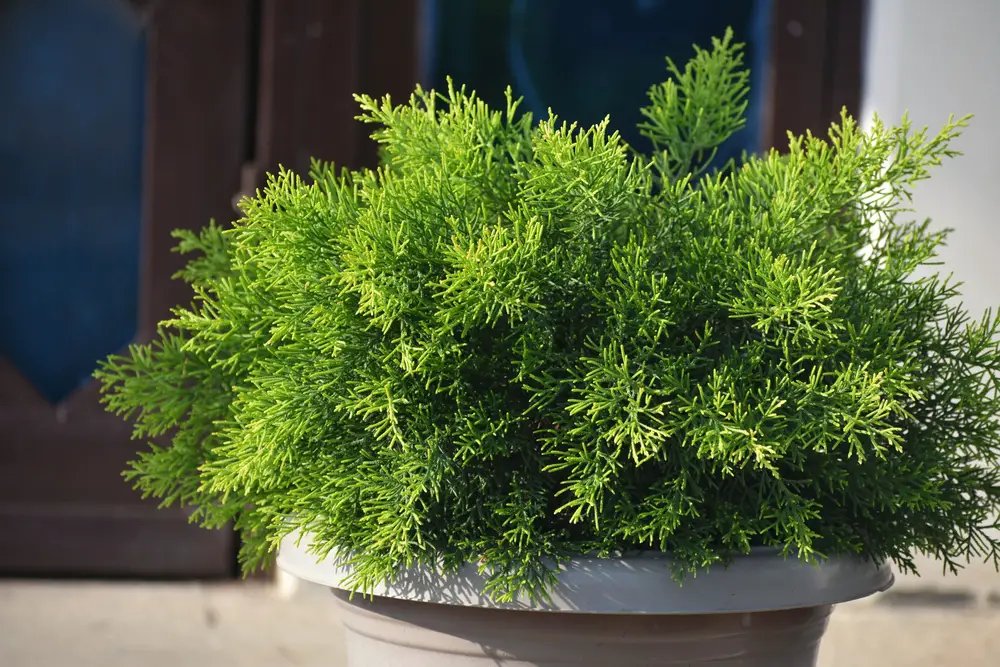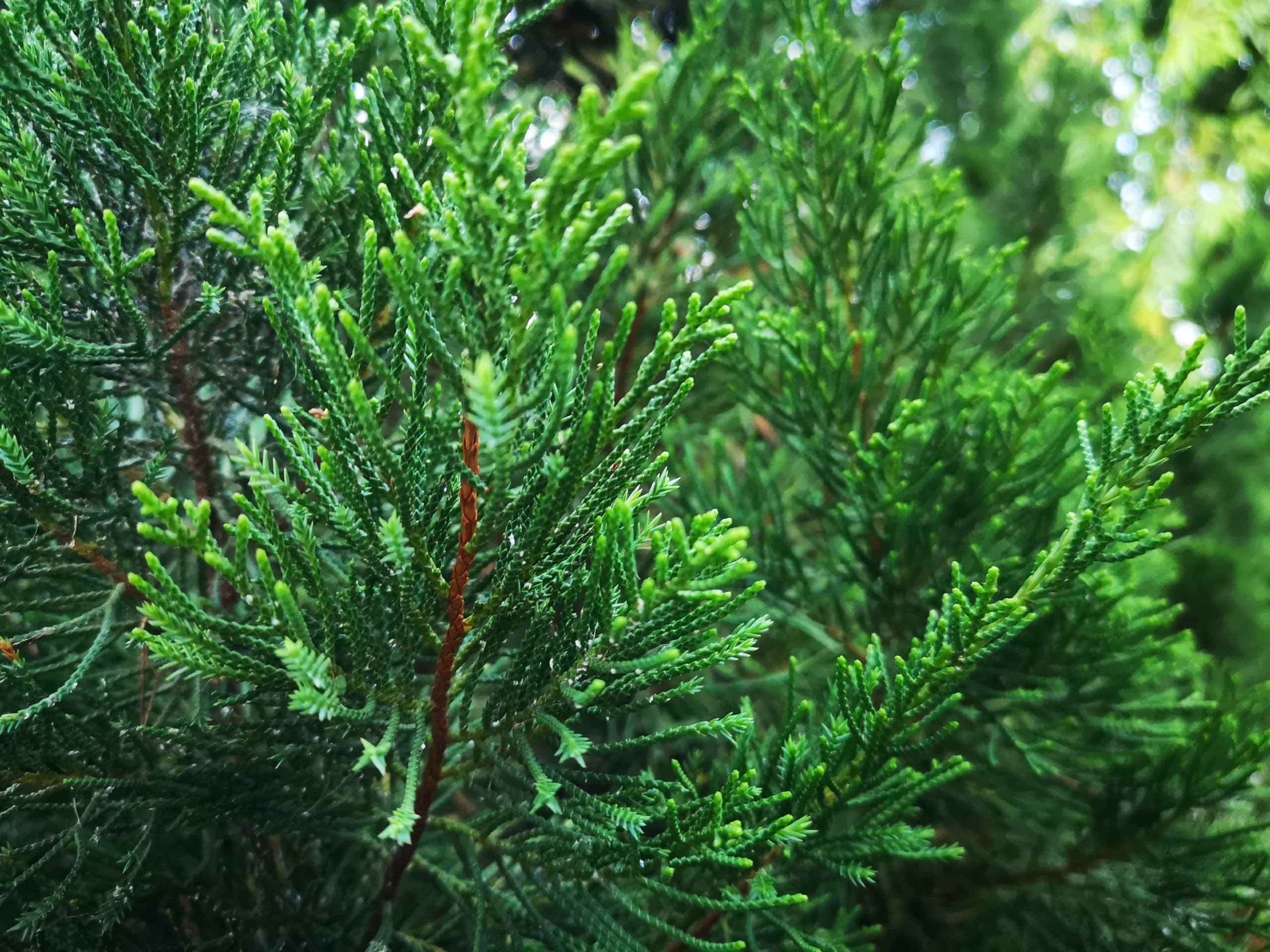The key to creating the ideal garden with minimum work requires tough, reliable plants.
The Brodie Juniper (Juniperus Virginiana ‘Brodie’ ) is a hardy, fast-growing coniferous evergreen you need in your garden. It’s handsome, with bright green, feather-light foliage growing in an upright form. Bark strips of red-brown, curl backward adding to its appeal. Even in the Spring, Brodie Juniper produces light yellow and maroon flowers. You can keep it as a shrub or help it grow into a beautiful tall tree of about 25 feet high.
As a native plant, it is the ideal choice for a natural garden or for improving natural areas, on banks or in rocky regions. It is also highly resistant to salt, making it the ideal choice for coastal areas and drought tolerant.
It has one core trunk, only noticeable at the ground until the tree reaches a certain age complemented with reddish-brown bark peels.
The foliage is a vibrant green with a fine texture. It takes on attractive gray-green to bronze-like shades during winter, depending on how much cold it was exposed to. The leaves are miniature scales that cover the younger stems tightly.
Where does Brodie Juniper grow best?
As a fast and moderate growing plant, it can reach a typical stature of 15 to 20 feet or more and a width of 8 to 15 feet.
It all depends on the weather and other environmental elements.
It thrives best when cultivated in sand, loam, clay, or silt soil that drains well or moderately. It is a good choice for beachy areas or for planting in sandy or rocky soils.
Best attributes of the Brodie Juniper
Brodie Junipers are also extremely tolerant of drought conditions and disease and can thrive in different soil. During late fall, they yield large amounts of dark blueberries.
of drought conditions and disease and can thrive in different soil. During late fall, they yield large amounts of dark blueberries.
The Brodie Juniper is a hardy plant that prospers in areas where other evergreens die.
It develops into a slender, vertical tree, reaching up to 15 feet in 10 years, and ultimately 25 feet or more.
It remains lean, just a few feet wide, making it a suitable choice for screening and trimming into hedges.
It thrives best in full sun and also grows in areas with minimal shade for part of the day. It can thrive well in any soil with proper drainage. Once it is established, it is highly lenient to both drought and warmth.
While it is cold-tolerant, the plant is ideal for warmer regions where drought-resistant is a significant factor.
It is seldom disturbed by pests or diseases, and deer rarely eat it. Brodie Juniper can tolerate salt spray well and even endures transitory periods of flooding with saltwater.
How to plant the Brodie Juniper
Brodie Juniper thrives well in neutral to minimally acidic, well-draining soil, including sandy locations.
Locations that receive full sun are the suitable planting site but can also grow in partial shade.
Brodie Juniper or Eastern red cedar are cone-shaped trees that boast fragrant dark green needles.
It can grow up to 24 inches in a year and live up to 150 years. You can find it in bare-root form during the early spring.
Planting the Brodie Juniper
On the chosen site that receives full to partial sun, remove any weeds, debris, or grass. You should plant in moist to dry soil since it cannot tolerate waterlogged soil. Inspect the roots and cut out any with damage or those that are too long.
Create a hole that is double as wide as the root as well as the depth. Pulverize any clumps of soil that you remove from the hole. Graze the borders of the hole to prevent the soil from compacting.
Form a mound of soil in the base of the hole. Position the roots in the hole, adding or taking out soil to elevate or sink the tree. Ensure that it is positioned at the same deepness at which it was formerly planted in the nursery. Distribute the roots over the sides of the mound.
Fill up the hole with soil while keeping the tree in a straight position and carefully press the soil throughout the roots.
Pour 3-5 gallons of water all over the roots’ base to allow the soil to settle. If the soil level depresses, add more soil and water.
If you decide to grow Brodie Juniper saplings, you can obtain one from a nursery, or it will even pop up from seeds deposited by birds if they are common in your area.
Cuttings
You can also propagate Brodie Junipers via cuttings. I recommend taking cuttings during late fall, winter, or spring when the tree is dormant while the sap has slowed down. I suggest taking cuttings early in the morning.
When growing one from cuttings, you need a 3 to 6-inch piece of the current year’s growth.
Select a branch that is supple and light brown. Slice it at a 45-degree angle. Nip off any foliage from the base and cover it in a moist paper towel. Submerge in a container of ice to keep it cold until ready for planting. Make sure that you will use the cuttings within an hour or two.

Place soilless potting mix in a pot. Soak the cut portion of the cutting in a rooting hormone, tap away any excess, and position the cutting into the soil. Flatten the soil securely down around the cutting.
Place the pot in a transparent plastic bag and seal using a twist tie. Keep them in a warm area with bright but indirect light.
Make sure you will mist the cuttings daily and close the bag properly after. Within four weeks, inspect the cuttings and give a slow tug. If there is resistance, the roots have formed.
It is time to transfer the cuttings into pots with regular soil after three months and bring them outdoors to adapt steadily. You can plant them into your garden in the late fall.
Seed Propagation
You can also propagate Brodie Juniper via seeds, but it will take a longer time. If you are not in a hurry, gather the fruit during the fall season.
I recommend picking only the ripe berries and get enough since the germination rates tend to vary. You can store the seeds as berries or clean seeds.
When obtaining the seeds, soften the fruit with a drop of detergent in a basin of water. The detergent works by helping the seeds move to the surface.
Collect the floating seeds and let them dry on paper towels. Keep the dried seeds in a sealed container in the refrigerator.
If you want to make the most out of natural chilling, sow the seeds in the fall.
Otherwise, the seed may be sown in the spring or summer, after a phase of stratification.
Before planting, you must stratify the seeds for a month.
Arrange the seeds between layers of moist peat moss. Place in sealable containers and keep in an area with a temperature range between 30-40 degrees F.
Once you have stratified the seeds, sow them during the spring in moist soil with a depth of ¼ inch.
If you trim it down, you should do it from early spring up to early fall. Do not trim back any branches that lack foliage. Remember that most evergreens could no longer produce sprouts from bare stumps.
Does Brodie Juniper require full sun?
It prefers to grow in a site with full sun or morning shade with afternoon sun.
Grow it under full sun, although it will tolerate minimal partial shade. As long as it is well-drained, any soil is suitable such as sandy, rocky, and even heavy clay.
How does Brodie Juniper grow?
The Brodie Juniper or Brodie Eastern Red Cedar is a popular cultivar of Juniperus virginiana due to its tapered pyramidal growth.
Brodie Junipers can grow up with a width of 12′ in maturity, making it a versatile choice for smaller landscapes and often used as privacy screens.
Brodie Juniper has a naturally dense canopy with dark green foliage that has a very smooth texture. Another advantage with the Brodie Juniper is the consistency of their canopies.
During spring, Brodie Juniper blooms with light yellow and maroon flowers with medium green foliage. It is beautiful, and if you like fragrance, Brodie Juniper has fragrant foliage.
When it comes to the fruit, the male cones are yellow and form at the branch tips.
As for the female cones, they are blue with a frosted appearance and quite abundant. The cones are round with a berry-like exterior and ripen in fall the first year.
Is Brodie Juniper poisonous?
Brodie Juniper is poisonous to humans with low severity, especially the flowers, leaves, and fruits.
It causes only low toxicity if consumed. When ingested in large amounts, it can cause diarrhea.
What are the other uses of Brodie Juniper?
The native tree is a recommended choice, ideally at the edge of a forest or beside the shore, and it is also gorgeous enough to be added to most gardens or lawns.
Brodie Juniper can be a great addition to any landscape as a screen, around decks or pools, in landscaping beds, to border corners of a house, to highlight entryways, and also in theme gardens.
The heartwood is light brown and aromatic, distinguished by the white sapwood, and widely used as cedar chests.
The wood is often utilized as fence posts and rails due to its rot-resistant qualities. It also repels some insects, making it a preferred choice as storage for clothing and pet bedding.
It is sometimes cultivated as Christmas trees, especially in the warmer areas.
Final Thoughts on Brodie Juniper
Brodie Juniper or Eastern Red Cedar is a lovely addition to any garden or lawn. Whether you will use one as a focal point, hedge, or as a privacy screen, the tree is a great addition that will make your property attractive.
Read more: Top 15 Evergreen Shrubs for Poor Soil

